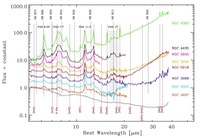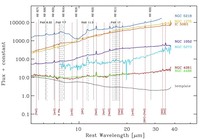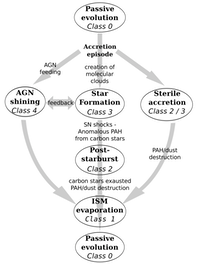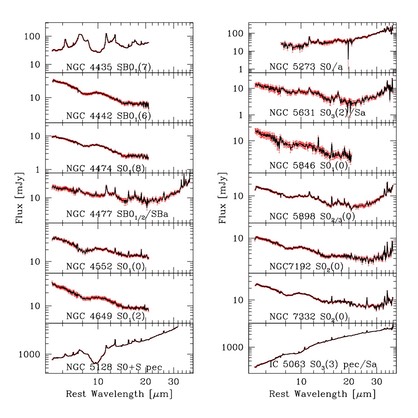Ellipticals and S0s, (early-type galaxies, ETGs) are the most luminous and massive stellar aggregates in the local Universe and posses a multiphase, sometimes conspicuous, interstellar medium (ISM). The Spitzer Space Telescope Heritage Archive (SHA) offers, in the mid-infrared (MIR) window, new tools in the endeavor of deciphering the evolutionary history of nearby ETGs.
Several Spitzer-IRS studies have been dedicated to unveil the MIR spectral characteristics of the nuclear region of ETGs, leading to the identification of Polycyclic Aromatic Hydrocarbons (PAHs) with both normal and anomalous inter--band ratios, as well as emission lines from molecular hydrogen (see old web pages). Studiesof the nuclear properties of ETGs in the Virgo cluster, succeded in identifying a class of passively evolving ETGs (Bressan et al. 2006). Their MIR spectra are characterized by the absence of ionic and molecular emission as well as of PAHs. Only the silicate emission at 10 micron from the circum-stellar dust of O-rich AGB stars leave their imprint in these spectra, superimposed on the photospheric stellar continuum generated by red giant stars. ETGs with a passive spectrum are very common in the Virgo cluster (16 out of 20) but this is not the case when galaxies are located in low density environments (LDEs). Their MIR spectra show a large variety of features. Notwithstanding, Panuzzo et al. (2011) attempt a classification of of MIR spectra of ETGs into a five classes. The majority of ETGs may be classified into three MIR classes displaying nebular and molecular H_2 emission without PAHs or with either normal or anomalous PAH ratios. The least populated class shows normal PAH ratios: these ETGs show ongoing star formation. Few spectra appears also dominated by the presence of an active galactic nucleus (AGN).
Given the short life time of PAHs within the ISM of ETGs (Clemens et al. 2010), Panuzzo et al. (2011) proposed that MIR classes may trace the evolutionary phases of a nucleus as the result of an accretion episode. Multi-wavelength observations of the Panuzzo et al. sample support this hypothesis (Annibali et al. 2007; Marino et al. 2011; Rampazzo et al. 2011). Accretion in ETGs may be the result of either secular evolution, driven by bar resonances, interaction or minor merger episodes which may induce nuclear star formation and/or AGN activity. Such activity, fading out with time, leaves traces in emission lines, PAH emission and the underlying continuum, until the nucleus returns to a passive state. MIR spectral classes may also offer snapshots of so-called AGN feedback i.e. the interaction between the energy and radiation generated by accretion onto the massive black hole with gas in the host galaxy. AGN feedback may arise where the intense flux of photons and particles, produced by the AGN, strips the interstellar gas, and may halt both star formation and accretion onto the AGN itself.
To test these hypotheses motivated us to use SHA for high S/N, low-resolution IRS spectra in the quest for a larger sample of well studied, nearby ETGs. To this end we used the Revised Shapley-Ames Catalogue of Bright Galaxies (RSA) (Sandage & Tammann 1987) as our starting point. RSA classifies 363 nearby galaxies as ETGs, although it is not a complete catalogue, it is certainly representative of bright nearby galaxies. We found 91 ETGs with Spitzer-IRS spectra with either LL or SL segments or both. We have homogeneously reduced and calibrated all this material producing an atlas of spectra and classified all spectra into the 5 MIR classes proposed by Panuzzo et al. (2011). The Atlas is intended to be a window on the MIR properties of the nuclear regions of nearby ETGs and to contribute to the understanding of their evolution. A local reference sample, made of well studied ETGs, may be used to make comparisons with numerous distant sources discovered by Spitzer-IRS (see e.g. Sargsyan et al. 2011) and for future space missions.
more details in
Rampazzo R.,, Panuzzo P., Vega O., Marino, A., Bressan A., Clemens, M.S.
A SPITZER-IRS Spectroscopic Atlas of Ealy-Type Galaxies in the RSA Catalogue
2013, MNRAS, in press.




